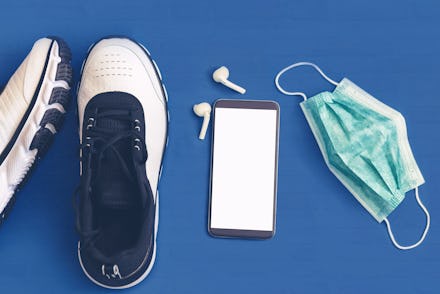Do I really need a mask when I’m running outside?

I wake up long before dawn to run on the New Orleans river levee. Generally, there are few other people around. It’s just me and the men who work on the docks, a few fishermen, and the occasional hoverboarding bro falling in the batteur because he’s still drunk from yesterday (true story). I don’t wear a mask, and until recently, I didn’t question this decision, but as the pandemic drags on, I am beginning to wonder if I should wear a mask when I run.
Given the identified patterns of coronavirus infection, running without a mask seems safe to me in a moment when almost nothing feels safe. But so far, there is only one documented case, from China, of COVID-19 being spread outdoors, and the “studies” suggesting that coronavirus could be transmitted from 65 feet away outdoors because of “spread droplets,” turned out to be bogus, Vice reported. Still, I don’t wanna be a vector when I grow up, so in an effort to be as responsible as possible, I consulted a specialist in infectious disease.
“Running outside without a mask very likely poses minimal to no risk to other individuals so long as the distance between the runner and others stays beyond 6 feet,” David Hirshwerk, an NYC-based infectious disease physician and professor at Donald and Barbara Zucker School of Medicine at Hofstra tells Mic. “It may be reasonable to bring a mask with you and place it on when you come into closer contact with others, or when passing people. But assuming that these are fleeting moments, its use is more to be thoughtful to other people and to demonstrate that you are trying to be considerate toward the health of others.” Wearing a mask when you run, then, can be more symbolic than necessary.
The situation is different if you are running with or near other people (hello, people in big, congested cities). “If non-household contacts are actually running together, they should maintain distancing and I think wearing a mask is sensible,” Hirshwerk says. So if you run in a populated area, like a track or a crowded park, the same coronavirus common sense applies there as it would to anywhere. Even if infection is unlikely outdoors, your symbolic participation in protecting people may lessen their anxiety, which is no small gift. “I was very surprised and impressed yesterday morning when I was in Central Park and saw that the vast majority of runners were wearing masks,” he says.
Runners who have been exercising mask-free in public spaces have been getting called out in major cities, like Washington, D.C., where anonymous notes were found by trail joggers imploring them to wear masks.
If someone is running towards you right now, you might just feel safer if they’re wearing a mask, even if infection is highly unlikely.
Why pick on us runners, though? What about dog walkers and the ubiquitous yoga babes? Is there something about running that makes it potentially more infectious than other outdoor activities?
“The deeper respirations associated with exercise, theoretically could present more virus from an infected individual into the environment,” Hirshwerk explains. “But, this theoretical risk is mitigated by being in an outside setting. Indoor running is more of a concern and a mask would be far more helpful in that scenario.” This drives home the point, I think, that we want runners to wear masks to mitigate anxiety rather than risk. If someone is running towards you right now, you might just feel safer if they’re wearing a mask, even if infection is highly unlikely.
Honestly, I am not going to wear a mask when I run. They get wet and it feels gross and there’s no one around at 5 a.m. that I can’t get several yards from within seconds. But, I will keep a mask in my pocket from now on, just to make the occasional still-drunken bro a little more comfortable.